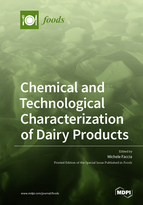Chemical and Technological Characterization of Dairy Products
A special issue of Foods (ISSN 2304-8158). This special issue belongs to the section "Dairy".
Deadline for manuscript submissions: closed (31 July 2020) | Viewed by 57441
Special Issue Editor
Interests: food biotechnology; dairy science; milk; milk quality; dairy management; dairy technology; milk proteins
Special Issues, Collections and Topics in MDPI journals
Special Issue Information
Dear Colleagues,
Milk processing is one of the most ancient food technologies, dating back to around 6000 B.C. A huge number of milk products have been developed worldwide, representing a spectacular example of biodiversity and a priceless cultural heritage. Commonly, they are divided into two main categories, with their own problems and objectives—industrial and artisanal. The industrial ones are produced by highly standardized technologies, and are under continuous evolution in order to follow the changes of consumers behavior. For these products, their main paths regard the safety and nutritional characteristics, without excluding environmental sustainability and ethic/religious aspects. Differently, artisanal products are manufactured according to traditional technologies, and among the most important topical issues are the relationships between animal welfare and quality, the impact of feeding on the nutritional characteristics, and the link with territory.
This Special Issue will focus on aspects such as dairy processing and the chemical analysis of dairy products, both industrial and artisanal. Nevertheless, the above indicated aspects are not exhaustive, and articles dealing with cheese proteomics and volatile organic compounds, the impact of alternative technologies on cheese quality, and innovative analytical techniques are also welcome.
Prof. Dr. Michele Faccia
Guest Editor
Manuscript Submission Information
Manuscripts should be submitted online at www.mdpi.com by registering and logging in to this website. Once you are registered, click here to go to the submission form. Manuscripts can be submitted until the deadline. All submissions that pass pre-check are peer-reviewed. Accepted papers will be published continuously in the journal (as soon as accepted) and will be listed together on the special issue website. Research articles, review articles as well as short communications are invited. For planned papers, a title and short abstract (about 100 words) can be sent to the Editorial Office for announcement on this website.
Submitted manuscripts should not have been published previously, nor be under consideration for publication elsewhere (except conference proceedings papers). All manuscripts are thoroughly refereed through a single-blind peer-review process. A guide for authors and other relevant information for submission of manuscripts is available on the Instructions for Authors page. Foods is an international peer-reviewed open access semimonthly journal published by MDPI.
Please visit the Instructions for Authors page before submitting a manuscript. The Article Processing Charge (APC) for publication in this open access journal is 2900 CHF (Swiss Francs). Submitted papers should be well formatted and use good English. Authors may use MDPI's English editing service prior to publication or during author revisions.
Keywords
- cheesemaking
- dairy product analysis
- traditional dairy products
- cheese proteomics
- VOCs







